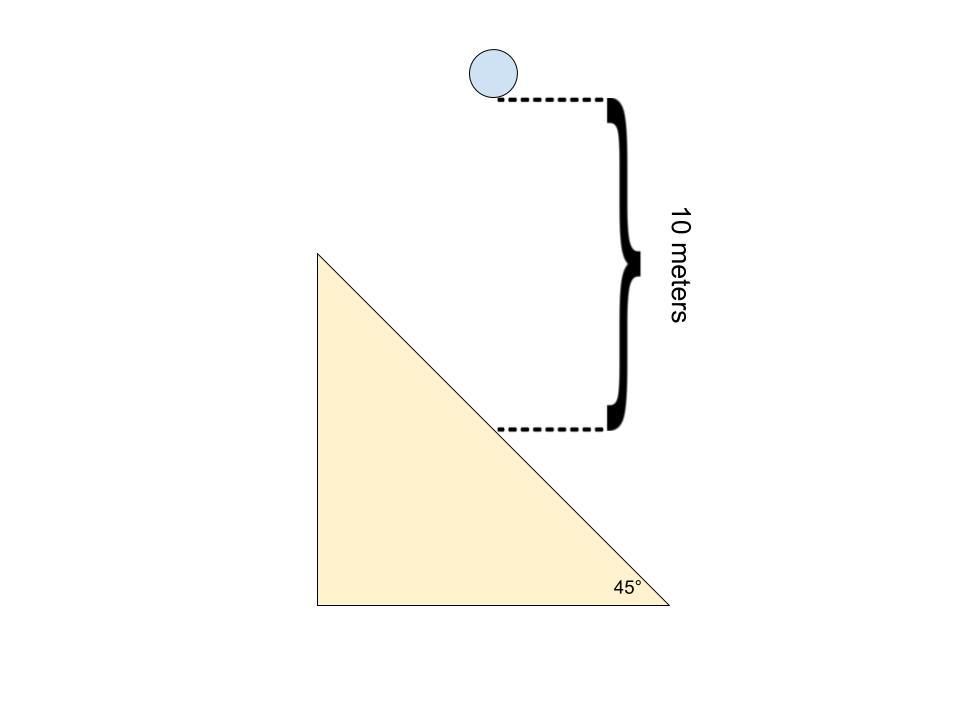Spaceballs (Parts 4 and 5)
You have two identical setups (shown below) on two separate planets, Earth and Zeta. On Earth, the acceleration due to gravity is ; on Zeta, the acceleration due to gravity is . On each planet, a ball is dropped from rest onto an inclined plank with an angle of elevation of 45° from a height of 10 meters. The balls are allowed to bounce all the way down the planks. What distance does the ball on Earth travel between its first bounce and its second bounce? What distance does the ball on Zeta travel between its first bounce and its second bounce?
Assumptions:
-
The two balls are identical.
-
There is no air resistance.
-
All collisions are perfectly elastic.
-
The planks are long enough for each ball to bounce at least twice.

This section requires Javascript.
You are seeing this because something didn't load right. We suggest you, (a) try
refreshing the page, (b) enabling javascript if it is disabled on your browser and,
finally, (c)
loading the
non-javascript version of this page
. We're sorry about the hassle.
Refer to Spaceballs (Part 1) to derive the graph that both balls follow on the xy-plane here .
y = 4 0 − x 2
Notice that since the balls follow the same graph, they will travel the same distance. To find how much distance the balls cover in the air, we first need to find when they will land again. We do this by defining the plank's position as y = − x on our xy-plane. Now, we need to see when each ball's path will hit the plank.
− x = 4 0 − x 2 x = 4 0 m y = − 4 0 m
To use the formula to find the arc length of a segment of a graph, we first need to find the derivative of the graphed function.
f ( x ) = 4 0 − x 2 f ′ ( x ) = 2 0 − x
We will plug this derivative (along with our x-boundaries of 0 and 4 0 into the formula for arc length.
S = ∫ a b 1 + [ f ′ ( x ) ] 2 d x S = ∫ 0 4 0 1 + [ 2 0 − x ] 2 d x S = ∫ 0 4 0 1 + 4 0 0 x 2 d x S = ∫ 0 4 0 4 0 0 4 0 0 + x 2 d x S = 2 0 1 ∫ 0 4 0 4 0 0 + x 2 d x
Perform a trigonometric substitution with x = 2 0 tan u .
x = 2 0 tan u d x = 2 0 sec 2 u d u u = tan − 1 2 0 x S = 2 0 2 0 ∫ 0 tan − 1 ( 2 ) 4 0 0 + 4 0 0 tan 2 u sec 2 u d u S = ∫ 0 tan − 1 ( 2 ) 4 0 0 ( 1 + tan 2 u ) sec 2 u d u S = 2 0 ∫ 0 tan − 1 ( 2 ) sec 2 u sec 2 u d u S = 2 0 ∫ 0 tan − 1 ( 2 ) sec 3 u d u
Use Integration by Parts to integrate ∫ sec 3 u d u .
m = sec u d m = sec u tan u d u d n = sec 2 u d u n = tan u
∫ sec 3 u d u = sec u tan u − ∫ sec u tan 2 u d u ∫ sec 3 u d u = sec u tan u − ∫ sec u ( sec 2 u − 1 ) d u ∫ sec 3 u d u = sec u tan u − ∫ sec 3 u d u + ∫ sec u d u 2 ∫ sec 3 u d u = sec u tan u + ln ∣ sec u + tan u ∣ + C 0 ∫ sec 3 u d u = 2 1 ( sec u tan u + ln ∣ sec u + tan u ∣ ) + C
Plug that whole thing back in.
S = 2 0 [ 2 1 ( sec u tan u + ln ∣ sec u + tan u ∣ ) ] ∣ 0 tan − 1 ( 2 ) S = 1 0 [ ( 5 ) ( 2 ) + ln ∣ ( 5 ) + ( 2 ) ∣ ] S = 5 9 . 1 5 7 7 m
Since both balls follow the same path, each ball travels a distance of 5 9 . 1 5 7 7 m .